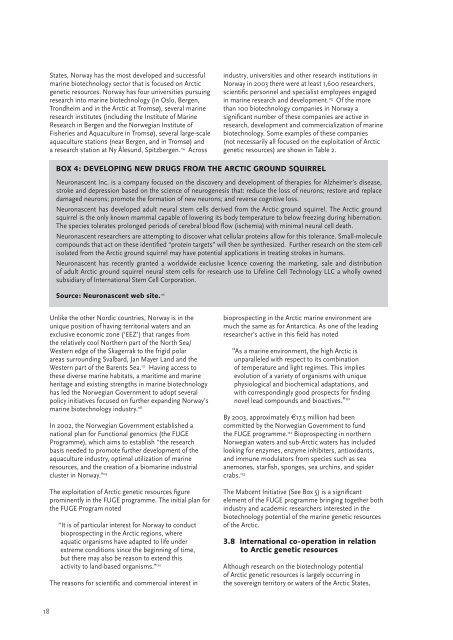Bioprospecting in the Arctic - UNU-IAS - United Nations University
Bioprospecting in the Arctic - UNU-IAS - United Nations University
Bioprospecting in the Arctic - UNU-IAS - United Nations University
Create successful ePaper yourself
Turn your PDF publications into a flip-book with our unique Google optimized e-Paper software.
18<br />
States, Norway has <strong>the</strong> most developed and successful<br />
mar<strong>in</strong>e biotechnology sector that is focused on <strong>Arctic</strong><br />
genetic resources. Norway has four universities pursu<strong>in</strong>g<br />
research <strong>in</strong>to mar<strong>in</strong>e biotechnology (<strong>in</strong> Oslo, Bergen,<br />
Trondheim and <strong>in</strong> <strong>the</strong> <strong>Arctic</strong> at Tromsø), several mar<strong>in</strong>e<br />
research <strong>in</strong>stitutes (<strong>in</strong>clud<strong>in</strong>g <strong>the</strong> Institute of Mar<strong>in</strong>e<br />
Research <strong>in</strong> Bergen and <strong>the</strong> Norwegian Institute of<br />
Fisheries and Aquaculture <strong>in</strong> Tromsø), several large-scale<br />
aquaculture stations (near Bergen, and <strong>in</strong> Tromsø) and<br />
a research station at Ny Ålesund, Spitzbergen. 114 Across<br />
Box 4: DEvELoPINg NEW DRUgS FRoM ThE ARCTIC gRoUND SqUIRREL<br />
Neuronascent Inc. is a company focused on <strong>the</strong> discovery and development of <strong>the</strong>rapies for Alzheimer’s disease,<br />
stroke and depression based on <strong>the</strong> science of neurogenesis that: reduce <strong>the</strong> loss of neurons; restore and replace<br />
damaged neurons; promote <strong>the</strong> formation of new neurons; and reverse cognitive loss.<br />
Neuronascent has developed adult neural stem cells derived from <strong>the</strong> <strong>Arctic</strong> ground squirrel. The <strong>Arctic</strong> ground<br />
squirrel is <strong>the</strong> only known mammal capable of lower<strong>in</strong>g its body temperature to below freez<strong>in</strong>g dur<strong>in</strong>g hibernation.<br />
The species tolerates prolonged periods of cerebral blood flow (ischemia) with m<strong>in</strong>imal neural cell death.<br />
Neuronascent researchers are attempt<strong>in</strong>g to discover what cellular prote<strong>in</strong>s allow for this tolerance. Small-molecule<br />
compounds that act on <strong>the</strong>se identified “prote<strong>in</strong> targets” will <strong>the</strong>n be syn<strong>the</strong>sized. Fur<strong>the</strong>r research on <strong>the</strong> stem cell<br />
isolated from <strong>the</strong> <strong>Arctic</strong> ground squirrel may have potential applications <strong>in</strong> treat<strong>in</strong>g strokes <strong>in</strong> humans.<br />
Neuronascent has recently granted a worldwide exclusive licence cover<strong>in</strong>g <strong>the</strong> market<strong>in</strong>g, sale and distribution<br />
of adult <strong>Arctic</strong> ground squirrel neural stem cells for research use to Lifel<strong>in</strong>e Cell Technology LLC a wholly owned<br />
subsidiary of International Stem Cell Corporation.<br />
Source: Neuronascent web site. 116<br />
Unlike <strong>the</strong> o<strong>the</strong>r Nordic countries, Norway is <strong>in</strong> <strong>the</strong><br />
unique position of hav<strong>in</strong>g territorial waters and an<br />
exclusive economic zone (‘EEZ’) that ranges from<br />
<strong>the</strong> relatively cool Nor<strong>the</strong>rn part of <strong>the</strong> North Sea/<br />
Western edge of <strong>the</strong> Skagerrak to <strong>the</strong> frigid polar<br />
areas surround<strong>in</strong>g Svalbard, Jan Mayer Land and <strong>the</strong><br />
Western part of <strong>the</strong> Barents Sea. 117 Hav<strong>in</strong>g access to<br />
<strong>the</strong>se diverse mar<strong>in</strong>e habitats, a maritime and mar<strong>in</strong>e<br />
heritage and exist<strong>in</strong>g strengths <strong>in</strong> mar<strong>in</strong>e biotechnology<br />
has led <strong>the</strong> Norwegian Government to adopt several<br />
policy <strong>in</strong>itiatives focused on fur<strong>the</strong>r expand<strong>in</strong>g Norway’s<br />
mar<strong>in</strong>e biotechnology <strong>in</strong>dustry. 118<br />
In 2002, <strong>the</strong> Norwegian Government established a<br />
national plan for Functional genomics (<strong>the</strong> FUGE<br />
Programme), which aims to establish “<strong>the</strong> research<br />
basis needed to promote fur<strong>the</strong>r development of <strong>the</strong><br />
aquaculture <strong>in</strong>dustry, optimal utilization of mar<strong>in</strong>e<br />
resources, and <strong>the</strong> creation of a biomar<strong>in</strong>e <strong>in</strong>dustrial<br />
cluster <strong>in</strong> Norway.” 119<br />
The exploitation of <strong>Arctic</strong> genetic resources figure<br />
prom<strong>in</strong>ently <strong>in</strong> <strong>the</strong> FUGE programme. The <strong>in</strong>itial plan for<br />
<strong>the</strong> FUGE Program noted<br />
“It is of particular <strong>in</strong>terest for Norway to conduct<br />
bioprospect<strong>in</strong>g <strong>in</strong> <strong>the</strong> <strong>Arctic</strong> regions, where<br />
aquatic organisms have adapted to life under<br />
extreme conditions s<strong>in</strong>ce <strong>the</strong> beg<strong>in</strong>n<strong>in</strong>g of time,<br />
but <strong>the</strong>re may also be reason to extend this<br />
activity to land-based organisms.” 120<br />
The reasons for scientific and commercial <strong>in</strong>terest <strong>in</strong><br />
<strong>in</strong>dustry, universities and o<strong>the</strong>r research <strong>in</strong>stitutions <strong>in</strong><br />
Norway <strong>in</strong> 2003 <strong>the</strong>re were at least 1,600 researchers,<br />
scientific personnel and specialist employees engaged<br />
<strong>in</strong> mar<strong>in</strong>e research and development. 115 Of <strong>the</strong> more<br />
than 100 biotechnology companies <strong>in</strong> Norway a<br />
significant number of <strong>the</strong>se companies are active <strong>in</strong><br />
research, development and commercialization of mar<strong>in</strong>e<br />
biotechnology. Some examples of <strong>the</strong>se companies<br />
(not necessarily all focused on <strong>the</strong> exploitation of <strong>Arctic</strong><br />
genetic resources) are shown <strong>in</strong> Table 2.<br />
bioprospect<strong>in</strong>g <strong>in</strong> <strong>the</strong> <strong>Arctic</strong> mar<strong>in</strong>e environment are<br />
much <strong>the</strong> same as for Antarctica. As one of <strong>the</strong> lead<strong>in</strong>g<br />
researcher’s active <strong>in</strong> this field has noted<br />
“As a mar<strong>in</strong>e environment, <strong>the</strong> high <strong>Arctic</strong> is<br />
unparalleled with respect to its comb<strong>in</strong>ation<br />
of temperature and light regimes. This implies<br />
evolution of a variety of organisms with unique<br />
physiological and biochemical adaptations, and<br />
with correspond<strong>in</strong>gly good prospects for f<strong>in</strong>d<strong>in</strong>g<br />
novel lead compounds and bioactives.” 121<br />
By 2003, approximately €17.5 million had been<br />
committed by <strong>the</strong> Norwegian Government to fund<br />
<strong>the</strong> FUGE programme. 122 <strong>Bioprospect<strong>in</strong>g</strong> <strong>in</strong> nor<strong>the</strong>rn<br />
Norwegian waters and sub-<strong>Arctic</strong> waters has <strong>in</strong>cluded<br />
look<strong>in</strong>g for enzymes, enzyme <strong>in</strong>hibiters, antioxidants,<br />
and immune modulators from species such as sea<br />
anemones, starfish, sponges, sea urch<strong>in</strong>s, and spider<br />
crabs. 123<br />
The Mabcent Initiative (See Box 5) is a significant<br />
element of <strong>the</strong> FUGE programme br<strong>in</strong>g<strong>in</strong>g toge<strong>the</strong>r both<br />
<strong>in</strong>dustry and academic researchers <strong>in</strong>terested <strong>in</strong> <strong>the</strong><br />
biotechnology potential of <strong>the</strong> mar<strong>in</strong>e genetic resources<br />
of <strong>the</strong> <strong>Arctic</strong>.<br />
3.8 International co-operation <strong>in</strong> relation<br />
to <strong>Arctic</strong> genetic resources<br />
Although research on <strong>the</strong> biotechnology potential<br />
of <strong>Arctic</strong> genetic resources is largely occurr<strong>in</strong>g <strong>in</strong><br />
<strong>the</strong> sovereign territory or waters of <strong>the</strong> <strong>Arctic</strong> States,

















